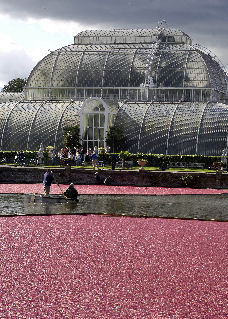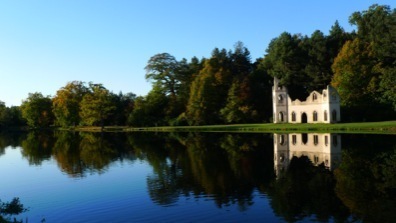Kew’s Autumn Harvest Festival
Description
Kew’s Autumn Harvest Festival
7 – 29 October 2006
Supported by Ocean Spray


Photographs by Roy Fisher, courtesy Ocean Spray
The 2006 autumn festival, supported by Ocean Spray, will see them bring to life their spectacular cranberry harvesting scenes typical to New England. In the wet harvesting of cranberries the fields are flooded and machines like eggbeaters dislodge the berries, allowing them to float to the surface creating huge swathes of red. Booms are then used to gather the cranberries from the water surface. This process will be recreated in an exciting display in the Palm House pond by floating over 5.3 million cranberries within booms. The history of the cranberry harvesting process and the growers’ cooperative will be explored in an exhibit, short film and photo display in the Princess of Wales Conservatory, and you can sample the end product in cranberry juice tasting sessions every weekend in the Temple of Arethusa.
30 Tonnes of Pumpkin
Back by popular demand this year is Kew’s spectacular display of cucurbits in the Waterlily House. 30 tonnes of pumpkins, gourds and squashes will be arranged into a spiralling tower. Learn how these strange looking fruits are cultivated, and the reasons for their use in folklore traditions. Elsewhere, there will be a 6 metre figure of a running man constructed from pumpkins. A variety of different sized pumpkin varieties, including Rocket, Racer and Howden Big Boy, will be cleverly used to carefully create his athletic form.
200 Varieties of Apple
This autumn you can discover some of the amazing diversity in apple varieties in a display of over two hundred types, in association with Brogdale, the national fruit collection. The exhibition will explore how the cultivation of species has led to such huge range of flavours, colours and smells and evocative names such as Sheep’s Snout, Brown Cockle, and Slack-my-girdle. Tasting sessions will give visitors the chance to relish a taste of Olde England, whilst Brogdale fruit and juices will be available to buy.
Nestled among the towns and villages of US and Canada are more than 17,000 acres of cranberry bogs – the workplace for nearly 600 farming families. For six generations these families have nurtured and cultivated the wetlands; provided shelter and habitat for native plants and animals; and helped to preserve the spectacular New England countryside.
Kew Gardens is a major international visitor attraction and its 132 hectares of landscaped gardens attract over one million visitors per year. Kew was made a UNESCO World Heritage Site in July 2003 and represents over 250 years of historical landscape. The site houses over 40 listed buildings and other structures including the Palm House, Temperate House, Orangery and Pagoda as well as two ancient monuments, Queen Charlotte’s Cottage and Kew Palace. RBG, Kew is a world famous scientific organisation, internationally respected for its outstanding living collection of plants and world-class herbarium as well as its scientific expertise in plant diversity, conservation and sustainable development in the UK and around the world. www.kew.org.


